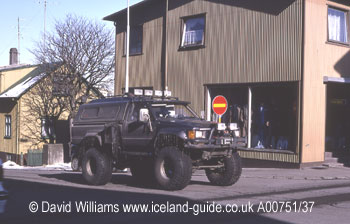 |
| This
winter view of Reykjavík has the mountain of Esja in the background. |
 |
| Many
Icelanders buy large 4x4 vehicles then adapt them for driving through
snow and across rivers. Or just to show off their new super-size tyres. |
In many ways
Reykjavík has the feel of a frontier town — and no
wonder, as the world`s most northerly capital is right on the edge of
inhabitable Europe. But instead of wild west cowboys riding in and tying
up their horses outside a saloon, on Friday nights Icelanders park their
massive four-wheel drive vehicles outside the Kringlan shopping mall,
pick up the shopping then head towards the weekend retreat — fording
a few rivers and crossing a desert or two en route.
As in a wild west town, Reykjavík`s roads can be dry and dusty
(and are in better condition than the pavements), but with one of the
world`s highest car ownerships, who bothers to walk anyway? (apart from
tourists, that is). Half the Icelanders seem to be driving about in these
huge 4x4 vehicles (many of them make Range Rovers look like Minis), wondering
who next to annoy on the car phone — these people are mad about gadgets.
The raised suspensions are designed for crossing rivers but their function
in the city is more for looking down at humble pedestrians.
All around Reykjavík you see images of this "frontier"
life; the buildings may not be architectural gems (concrete and corrugated
iron abound) but inside they feature the very best in Nordic and North
American interior designs. The modern Icelandic economy only really started
to develop in the 1940s when British (and then US) troops took over the
island in order to stop the Germans from doing the same thing. The occupation
started an economic boom — airfields, roads and houses were built
and the Icelanders rushed headlong into a spending spree. They haven`t
stopped spending since then and today the smart clothes shops sit quite
happily near stores selling fishermen`s gear or software for the latest
in home computers.
Back
to the list of articles about this country
|

